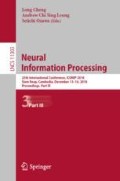Abstract
Spatial invariance to geometrically distorted data is of great importance in the vision and learning communities. Spatial transformer network (STN) can solve this problem in a computationally efficient manner. STN is a differentiable module which can be inserted in a standard CNN architecture to achieve spatial transformation of data. STN and its variants can handle global deformation well, but lack the ability to deal with local spatial variation. Hence how to achieve a better manner of spatial transformation within a neural network becomes a pressing matter of the moment. To address this issue, we design a module to estimate the difference between the ground truth and STN output. The difference is measured in the form of motion field. The motion field is utilized to refine the spatial transformation predicted by STN. Experimental results reveal that our method outperforms the state-of-the-art methods in the cluttered MNIST handwritten digits classification task and planar image alignment task.
Access this chapter
Tax calculation will be finalised at checkout
Purchases are for personal use only
References
Bay, H., Ess, A., Tuytelaars, T., Van Gool, L.: Speeded-up robust features. Comput. Vis. Image Underst. 110(3), 404–417 (2008)
Bhagavatula, C., Zhu, C., Luu, K., Savvides, M.: Faster than real-time facial alignment: a 3d spatial transformer network approach in unconstrained poses. In: The IEEE International Conference on Computer Vision, vol. 2, p. 7 (2017)
Bookstein, F.L.: Principal warps: thin-plate splines and the decomposition of deformations. IEEE Trans. Pattern Anal. Mach. Intell. 11(6), 567–585 (1989)
Brox, T., Bruhn, A., Papenberg, N., Weickert, J.: High accuracy optical flow estimation based on a theory for warping. In: Pajdla, T., Matas, J. (eds.) ECCV 2004. LNCS, vol. 3024, pp. 25–36. Springer, Heidelberg (2004). https://doi.org/10.1007/978-3-540-24673-2_3
Brox, T., Malik, J.: Large displacement optical flow: descriptor matching in variational motion estimation. IEEE Trans. Pattern Anal. Mach. Intell. 33(3), 500 (2011)
Bruna, J., Mallat, S.: Invariant scattering convolution networks. IEEE Trans. Pattern Anal. Mach. Intell. 35(8), 1872–1886 (2013)
Chang, C.H., Chou, C.N., Chang, E.Y.: CLKN: Cascaded Lucas-Kanade Networks for image alignment. In: The IEEE Conference on Computer Vision and Pattern Recognition (2017)
De Boor, C.: A Practical Guide to Splines. Springer, Heidelberg (1978)
Galway, L.: Spline Models for Observational Data. Siam, Philadelphia (1990)
Jaderberg, M., Simonyan, K., Zisserman, A., et al.: Spatial transformer networks. In: Advances in Neural Information Processing Systems. pp. 2017–2025 (2015)
Kanazawa, A., Sharma, A., Jacobs, D.: Locally scale-invariant convolutional neural networks. Comput. Sci. (2014)
Kingma, D., Ba, J.: Adam: a method for stochastic optimization. Comput. Sci. (2014)
Lecun, Y., Cortes, C.: The MNIST database of handwritten digits (2010)
Leutenegger, S., Chli, M., Siegwart, R.Y.: BRISK: binary robust invariant scalable keypoints. In: The International Conference on Computer Vision, pp. 2548–2555 (2011)
Lin, C., Lucey, S.: Inverse compositional spatial transformer networks. In: The IEEE Conference on Computer Vision and Pattern Recognition, pp. 2252–2260 (2017)
Liu, C., Yuen, J., Torralba, A.: Sift flow: dense correspondence across scenes and its applications. IEEE Trans. Pattern Anal. Mach. Intell. 33(5), 978–994 (2011)
Lowe, D.G.: Distinctive image features from scale-invariant keypoints. Int. J. Comput. Vis. 60(2), 91–110 (2004)
Peng, Y., Ganesh, A., Wright, J., Xu, W., Ma, Y.: RASL: robust alignment by sparse and low-rank decomposition for linearly correlated images. IEEE Trans. Pattern Anal. Mach. Intell. 34(11), 2233–2246 (2012)
Ronneberger, O., Fischer, P., Brox, T.: U-Net: convolutional networks for biomedical image segmentation. In: Navab, N., Hornegger, J., Wells, W.M., Frangi, A.F. (eds.) MICCAI 2015. LNCS, vol. 9351, pp. 234–241. Springer, Cham (2015). https://doi.org/10.1007/978-3-319-24574-4_28
Simard, P.Y., Steinkraus, D., Platt, J.C., et al.: Best practices for convolutional neural networks applied to visual document analysis. In: International Conference on Document Analysis and Recognition, vol. 3, pp. 958–962 (2003)
Sohn, K., Lee, H.: Learning invariant representations with local transformations. In: International Conference on Machine Learning, pp. 1339–1346 (2012)
Stollenga, M.F., Masci, J., Gomez, F., Schmidhuber, J.: Deep networks with internal selective attention through feedback connections. In: Advances in Neural Information Processing Systems, pp. 3545–3553 (2014)
Wah, C., Branson, S., Welinder, P., Perona, P., Belongie, S.: The Caltech-UCSD birds-200-2011 dataset (2011)
Wu, W., Kan, M., Liu, X., Yang, Y., Shan, S., Chen, X.: Recursive spatial transformer (rest) for alignment-free face recognition. In: The IEEE International Conference on Computer Vision, pp. 3792–3800 (2017)
Zhang, H., He, X.: Deep free-form deformation network for object-mask registration. In: The IEEE Conference on Computer Vision and Pattern Recognition, pp. 4261–4269 (2017)
Acknowledgments
This paper is supported by National Science Foundation of China (No. 61673381, 61201050, 61701497), Scientific Instrument Developing Project of Chinese Academy of Sciences (No. YZ201671), Bureau of International Cooperation, CAS (No. 153D31KYSB20170059), and Special Program of Beijing Municipal Science & Technology Commission (No. Z161100000216146).
Author information
Authors and Affiliations
Corresponding author
Editor information
Editors and Affiliations
Rights and permissions
Copyright information
© 2018 Springer Nature Switzerland AG
About this paper
Cite this paper
Shu, C., Chen, X., Yu, C., Han, H. (2018). A Refined Spatial Transformer Network. In: Cheng, L., Leung, A., Ozawa, S. (eds) Neural Information Processing. ICONIP 2018. Lecture Notes in Computer Science(), vol 11303. Springer, Cham. https://doi.org/10.1007/978-3-030-04182-3_14
Download citation
DOI: https://doi.org/10.1007/978-3-030-04182-3_14
Published:
Publisher Name: Springer, Cham
Print ISBN: 978-3-030-04181-6
Online ISBN: 978-3-030-04182-3
eBook Packages: Computer ScienceComputer Science (R0)

